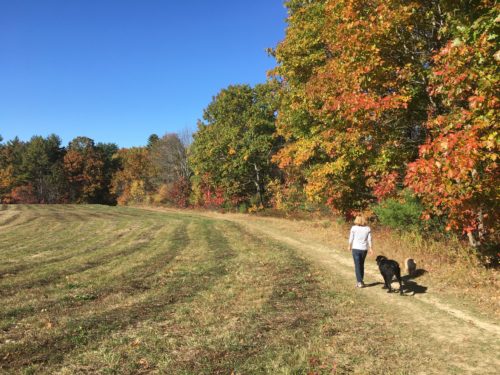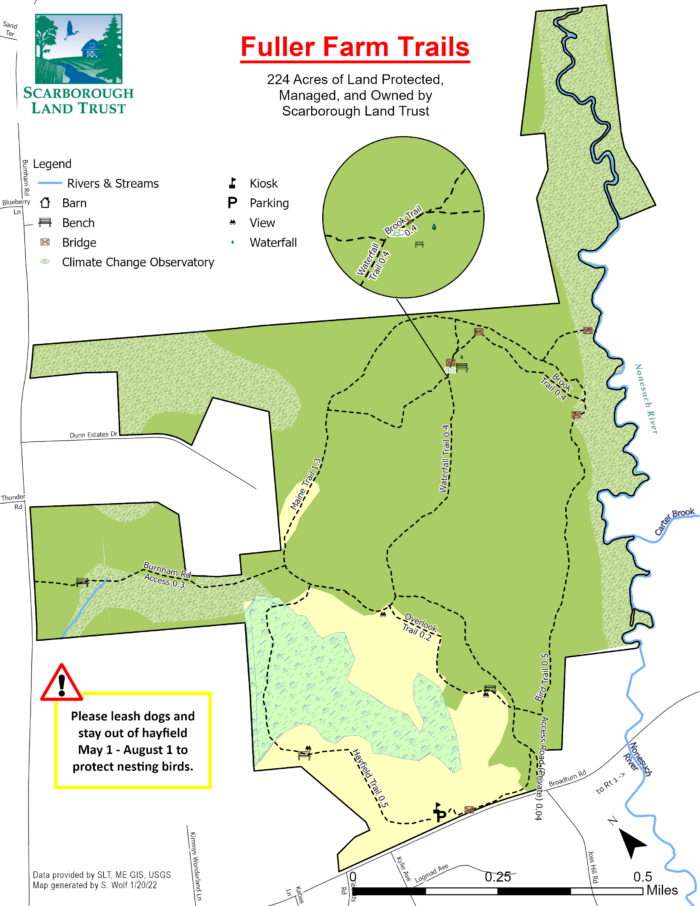Fuller Farm Preserve has our largest trail network and is one of our most popular properties. It features large open fields, woods trails, a springtime waterfall, and frontage on the Nonesuch River. Located on Broadturn Road, just one mile from Broadturn Farm.
Trails: 4 miles
Land: 224 acres
Open year round, dawn to dusk.
Leave no trace.
The Trails
4 miles of trails, with many loop options.
Waterfall Trail 0.4 mi
Brook Trail 0.4 mi
Bird Trail 0.5 mi
Maine Trail 1.5 mi
Hayfield Trail 0.5 mi
Overlook Trail 0.3 mi
Burnham Rd Access Trail 0.3 mi
The Waterfall Trail and Brook Trail have natural trail beds with roots and rocks, are narrow at times, and many inclines, some of which are steep.
The Bird Trail features a long raised boardwalk, and some steep areas.
The Maine Trail is a mix of mowed grass, dirt lane, and natural trail beds with roots and rocks and some steep areas.
The Hayfield trail is a mix of mowed grass and boardwalk and features a bench. There is one short incline.
The Overlook Trail is mowed grass with an incline and some wet areas. There is a bench on the Overlook Trail close to the junction with the Bird trail.
The Burnham Rd access trail is a natural trail bed with roots and rocks, and crosses a stream. There is a bench closest to the road-end of the trail. Note- there is no designated parking for this access point.
How to get there
Get directions to the trailhead location.
Activities
- Hiking, wildlife-watching, snowshoeing, cross-country skiing.
- Dogs must be leashed or under voice control at all times. NOTE: All dogs must be leashed on the Hayfield Trail during bird nesting season, May 1- Aug 1.
- For the benefit of visitors and wildlife, no drones.
- Hunting is allowed with SLT notification. Visitors are encouraged to wear blaze orange during hunting season. No hunting is permitted on Sundays in Maine.
- Any collecting, foraging or commercial activity requires a permit from SLT. No exceptions.
Want to join others who help maintain these trails for the community?
The Land
224 acres
Natural Features
Sweeping open fields, woods, wildlife, abundant birdlife, streams, spring waterfall, frontage on the Nonesuch River. Spring and summer bring nesting bobolinks in the fields filled with buttercups and blue flag iris.
History & Current Use
In 2001, SLT purchased the 150-acre property from the Fuller family. For almost 100 years, Fuller Farm had been farmed for crops, livestock and hay. We purchased an additional 30-acre abutting property from Blue Rock Industries. In 1997, 38 acres were transferred to the Land Trust as part of the Town’s Open Space Requirement for the Dunn Estates development. And in 2022, we purchased approximately eight acres from the George Baker family. The Fuller Farm, Blue Rock, Dunn Estates, and Baker properties are managed together as Fuller Farm Preserve and total 226 acres.
The Overlook Trail features a bench made and donated by Royce O’Donal and provides sweeping views of the front fields and glorious sunsets. In 2016, Eagle Scout Jacob Murphy made and installed two benches on the Hayfield and Waterfall Trails, and two wayfinding signs at the Maine and Overlook Trails, and the Waterfall Trail. A memorial bench dedicated to George Baker was added to the eight-acre parcel in the summer of 2023. Woods trails include bridge crossings over streams and bog bridges in wet areas.
Support for the purchase of Fuller Farm came from individuals and foundations, the Town of Scarborough, and the Land for Maine’s Future program. The Trust for Public Land was also a project partner. Support for the purchase of the Baker property came from a bargain sale, or below market sale, from the Baker family, as well as funding from the Town of Scarborough Land Bond, Maine Natural Resource Conservation Program (MNRCP), Bass Pro/Cabela’s, and individual donors.
Managing for Bird Habitat
Fuller Farm protects a diverse collection of habitats including woodlands, wetlands, and meadow. SLT manages the hayfield at Fuller Farm for grassland birds, including Bobolink and Meadowlark. Many species of birds can be seen utilizing the hayfield and the woodland edge habitat through out the year. Some habitat management practices include:
- mowing after nesting season in late summer
- controlled prescribed burns before nesting season in the early spring
- limiting access to the hayfield and requiring leashing dogs around the hayfield from May 1- Aug 1
- expanding the hayfield habitat by selectively cutting tree regrowth every few years
- adding Bluebird boxes to the field edge
Information about Bobolink Nesting Grounds
Bobolink populations have been in decline across New England due to habitat loss. These charismatic birds require large open grassland areas to nest from May 1st to August 1st. They return to the Fuller Farm hayfield annually, so listen for their distinct robotic sounding call all summer long. Learn more about Bobolinks and efforts to protect them through our partner, The Bobolink Project.

Male Bobolink – South Okanagan, BC
Information about Bluebird Nesting Boxes





